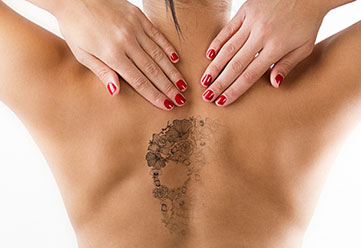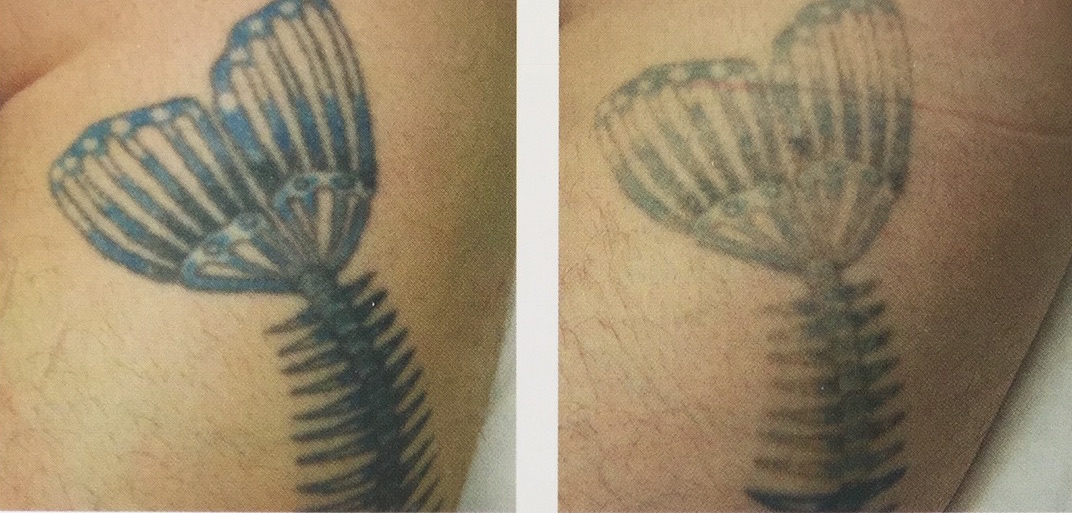Affected area: Face-Body-Limbs
Execution: 30 minutes
Back to social life: immediate or 24h
Anesthesia: none
Sun exposure after surgery: 2 months
Laser: Q-Switched – Revlite

TATTOO REMOVAL
The rising popularity of tattoo art has also inevitably led to a huge increase in requests to remove some of them, totally or in part.
Thanks to the use of lasers, tattoo removal is more and more frequent and can be achieved with an excellent degree of satisfaction. Depending on the size, color of the tattoo as well as the depth to which the pigment has been injected, a total or partial cleaning can be achieved, which in any case allows the correction of the tattoo itself by dedicated professionals.
A survey indicated that around 1 in 8 people regret getting a tattoo and would like to have it removed. The most common reasons are:
- I was too young when I decided to do it.
- It is permanent and has marked me for life.
- It creates problems for me at work and in social relationships.
- I do not like it anymore.
In general, tastes change and evolve over time and something that can be enjoyed in youth can take on different connotations as one grows.
Surely the easiest way to erase a tattoo is to cover it with a new one (Cover up). The problem is that the new tattoo will be larger and will require darker tones to actually make the old design invisible. Lasers are used to fade the old colors, in order to make coverage easier.
The removal of tattoos has been attempted with different tools throughout history and although today the laser has become the golden rule, it too has had its stages of evolution. Initially a continuous wave laser was used, then, in the early 1990s, the so-called Q-switch laser became available, which allows the non-invasive removal of colored pigments (especially the darker ones).
The laser essentially accelerates the natural process of dissolving pigments. The laser must emit the amount of energy that perfectly matches the absorption spectrum of the inks to obtain an effective result.
The Q-switch is the most commonly used laser to remove tattoos and usually takes more than one session. It is a totally harmless procedure and rarely generates scars. To soothe the slight discomfort that the operation causes, a superficial anesthetic is usually applied.
HOW DOES IT WORK?
Tattoos are made up of thousands of pigment particles that remain suspended within the skin tissue. The human body is used to expelling foreign particles, but those of the inks are too large to be removed. The laser treatment, in essence, by heating of these particles, fragments them into smaller pieces that can thus be easily eliminated.
The theory behind the process is called selective photothermolysis and its functioning depends on 3 factors:
- The color of the light, which must penetrate sufficiently to reach the pigment and be absorbed by it more than the surrounding skin (different types of tattoos require different laser colors, for example red light is strongly absorbed by the pigments of green tattoos).
- The duration of the laser pulse, which must be very short (in the order of nanoseconds); enough time to break up the molecules before the heat is dispersed to the surrounding skin (prolonged exposure could cause burns or scars).
- The energy of the pulse that must be perfectly adjusted (too low an energy will not fragment the pigment).
HOW LONG DOES A TREATMENT LAST?
A single session can last from 5 to 30 minutes depending on the width of the target tattoo and the number of colors.
To obtain the complete cancellation of the tattoo, a few sessions are required, generally spaced 4-6 weeks apart.
More frequent treatment increases the risk of undesirable effects and is not functional to a better outcome .
The number of sessions depends on some criteria:
- Skin type
- Tattoo colors
- Position
- Amount of ink
- Stratification
- Presence of scars
The result is a tattoo that "fades" over the months. Light areas will appear gradually larger session after session, until the desired result is obtained.
It should be noted that the time required to achieve the full result varies depending on: the type of skin, the position, the color, the quality of the ink, the stratification of the skin.
IS IT PAINFUL?
Generally , slight discomfort is felt during the session , but it’s tolerable in the vast majority of cases. As mentioned, in cases where the pain threshold is very low, local anesthetic creams can be used.
WHAT SHOULD BE DONE AFTER THE TREATMENT?
Often there is a whitish discoloration of the entire area affected by the laser. Localized erythema and redness are also very
low, local anesthetic creams can be used.
WHAT SHOULD BE DONE AFTER THE TREATMENT?
Often there is a whitish discoloration of the entire treated area. Localized erythema and redness are also very common but disappear in about 24 hours. Subsequently, a small scab forms all over the tattoo, which also heals completely within a couple of weeks. There may be some slight swelling and redness of the skin surrounding the tattoo; this reaction is also normal and resolves in a few hours. Most laser-treated tattoos cause itchiness that lasts for a few days, with the sensation of dry, flaky skin. In these cases it is useful to use a moisturizer.
LASER
Q-Switch Revlite®
The equipment used is state of the art. The QS laser sector is the one that has undergone the most technical improvements. Modern machinery and up-to-date softwares yield better results with fewer applications and faster success. CON-BIO is the leading company in this field and its REVLITE the reference model. It is a powerful, versatile and reliable device that has now reached the third generation, always demonstrating its role as a leader in this sector.
A FEW EXAMPLES OF Q-Switch LASERS




